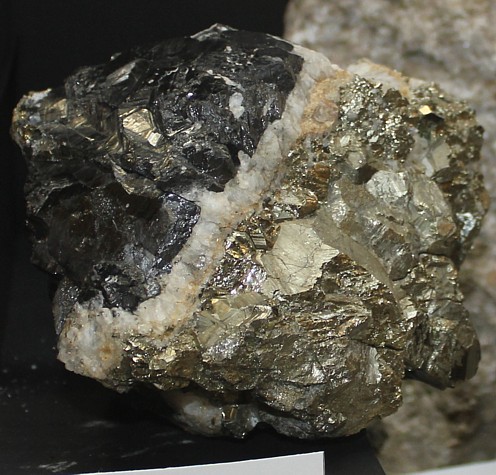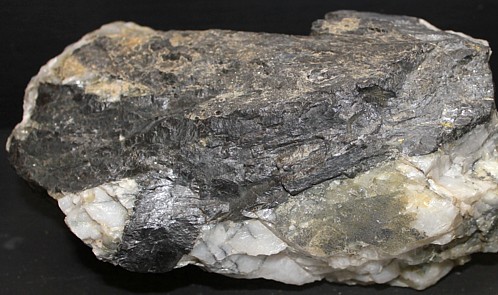|
.
Wolframite Mineral Facts:
Chemical Formula:
(Fe,Mn)WO4
The tungstate of
ferrous iron and manganese.
Wolframite is the isomorphous mixture of manganese
and iron tungstates. The nearly pure end members are the minerals hubnerite
(Mn rich)and ferberite (Fe rich).
Colors:
Brownish Black.
Streak
from nearly black to red-brown.
Hardness:
5 to 5.5
Density: 7.2
to 7.5
Cleavage:
Perfect cleavage on
(010).
Crystallography: Monoclinic
Crystals
commonly tabular
parallel to the orthopinacoid, giving bladed forms.
Found in
bladed, lamellar or columnar forms.
Twins are fairly common. The
mineral also
occurs in lamellar and granular masses.
Luster:.
Submetallic to resinous
luster. It is slightly translucent to opaque.
|

Wolframite (black) with quartz and pyrite |
|
Composition,
Structure and Associated Minerals:
Wolframite is a comparatively rare mineral, and is normally found usually with
cassiterite and associated also with scheelite, bismuth, quartz,
pyrite,
galena,
sphalerite, etc.
It is found in fine crystals from Schlaggenwald,
Bohemia, and in the various tin districts of Saxony and Cornwall.
Wolframite occurs in the United States in the Black Hills, South
Dakota; Boulder County, Colorado; Seward Peninsula, Alaska.
Hubnerite is found near Butte, Montana; and in various localities in
Nevada and Arizona.
It has been suggested that the name ferberite be limited
to mixtures containing not more than 20 per cent of the hubnerite molecule
and the name hubnerite to those containing not more than 20 per
cent of the ferberite molecule. This would leave the name wolframite
for mixtures containing more than 20 per cent of both FeWO4 and MnWO4.
As in other isomorphous series of this kind, there is a gradation
in physical properties, and in this particular case the color deepens
and the mineral becomes more opaque as the percentage of iron increases.
The mixture of the iron and manganese molecules is more common
than either alone, consequently wolframite is the commonest member of
the group. The properties of all three minerals, however, are so nearly
alike that they must be distinguished by chemical analysis.
|

Wolframite (Black) |
|
|
Identification
and Diagnostics
Before
the blowpipe it fuses to a globule which is magnetic. Fused with
soda and niter on platinum it gives the bluish green manganate, indicating presence of manganese. The
salt of phosphorus bead is reddish yellow when hot and a paler tint
when cold. In the reducing flame the bead becomes dark red. If
the mineral is treated first on charcoal with tin its bead assumes a
green color on cooling. The mineral dissolves in aqua regia with
the production of the yellow tungsten trioxide. When treated with
concentrated H2SO4 and zinc it yields the blue tungsten reaction.
Crystals of wolframite are easily distinguished from crystallized
columbite, samarskite, and
uraninite, by
differences
in crystallization. Massive wolframite is distinguished from
massive forms of the other three minerals by its more perfect cleavage
and by the reactions with the beads. Uraninite, moreover, contains small
amounts of
lead. Wolframite is distinguished from black
tourmaline by
the differences in specific gravity.
Occurrence,
Localities and Origins:
Wolframite usually occurs in veins with
casseterite tin
ores, and in quartz veins with various sulfides, and in pegmatite.
Its origin is probably pneumatolytic. Localities Wolframite is found in all
tin-producing districts, especially
at Zinnwald, Schneeberg and Freiberg, in Germany; at Nerchinsk,
in Siberia; in Cornwall, England; at Oruro, in Bolivia, and at
various points in New South Wales, Australia.
In the United States it occurs at Monroe, Conn.; near Mine La
Motte, Missouri; near Lead, South Dakota, where it impregnates a
sandy dolomite, and at Hill City in the same State in quartz veins,
sometimes containing cassiterite; in Boulder Co., Colorado, in veins in
granite ; near Butte, Montana, in
quartz veins carrying
silver ore; and the quartz-cassiterite veins near Nome
and on Bonanza Creek, in Alaska; and in quartz veins at various
points in Washington, Idaho, California, Nevada, New Mexico and Arizona. Some of the
ore shipped from western US operations has been obtained from placers along streams that drain
regions containing the mineral in veins, but most of it has been obtained
from vein rock which is crushed and concentrated.
Uses:
Wolframite is by far the most important
tungsten ore mineral,
scheelite being much less important. Tungsten is used as a hardening
metal in the manufacture of tool steel and other important steel alloys.
Tungsten is one of the most valuable of the steel-hardening metals.
Tungsten steel is very tough. It possesses the valuable property of
retaining its temper when very hot, and on that account is used in the
manufacture of high-speed tools. Tungsten is also useful as a substitute for platinum in the manufacture of contact points.
It also serves as a filament
in incandescent electric lights. Sodium tungstate is used in
fire-proofing cloth,
to impregnate wood and render it
fireproof,
and as a mordant in the dyeing trades.
Return to the
Mineral Collectors Information Page
|


